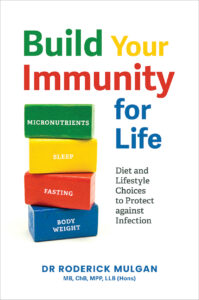 Extract from Build Your Immunity for Life by Dr Roderick Mulgan MB ChB MPP LLB (Hons), Calico Publishing, RRP $39.95
Extract from Build Your Immunity for Life by Dr Roderick Mulgan MB ChB MPP LLB (Hons), Calico Publishing, RRP $39.95
Copper has various effects on your metabolism and your immunity, but this mineral is particularly helpful for baby blood cells growing in bone marrow. Unfortunately, the soil we grow our food in is running out of it. Our crops deliver us far less copper than in generations past and our immunity sags as a consequence. Copper in the Western diet has been decreasing at least since the 1930s and we do not even make the most of what we can get. Copper is a victim of sugar, which the modern world swims in, as sugar stops your gut absorbing it. It is also a victim of excessive meat, as the zinc in meat does much the same.
New blood cells growing in bone marrow can become any type of adult blood cell, and copper is part of the mix that sets them on the right path. People without enough copper often have inadequate blood cells, both red and white. Rats with insufficient copper have deformed spleens and thymus glands. Lymphocytes inside deficient thymuses and spleens have abnormally shaped nuclei, which are the HQ organelles that direct cell functions.
Copper also has the useful property of being toxic to bacteria. It disrupts their essential proteins, and your immune system makes use of that. When infections rampage, your blood levels of copper rise. They also rise in tissues where infections are focused, such as lungs and kidneys. Macrophages bombard invading bacteria like Escherichia coli (E. coli) and Salmonella with copper. Even hospital planners have caught on: there is research under way to coat worktops in hospitals with copper to stop bacteria growing on them.
The bugs, for their part, come prepared with special proteins called metallothioneins that bind copper to neutralise it and enzymes that push copper back out through their external membranes. It is a battle of bombs and bomb disposal.
Laboratory rats and mice kept on a diet with inadequate copper get infectious diseases more often and have less capacity to fight them once they are on board. Likewise, when copper-deficient rats are injected with something foreign, like red blood cells from a sheep, they produce fewer antibodies against it than regular rats do.
Unfortunately, many people do not have enough copper, particularly, but not exclusively, the elderly. Working out who is affected is not straightforward, as there is no ready measure for how much you have (discussed below). Nevertheless, various health authorities publish figures based on indirect determinations, such as how much a person is likely to lose every day. From these, it is possible to state, at least in broad terms, whether routine diets are delivering enough. One study in Greece showed that up to 8% of children and close to 40% of adults had deficient intakes of copper. In Chile, inadequate intake was found in a fifth of women and a third of men. In Scandinavia, a study of people aged 65 and over showed deficient intakes for 14% of men and 18% of women.
The National Health and Nutrition Examination Survey in the United States has included copper in the last decade. It initially reported that 29% of its respondents did not meet the
recommended daily intake; more recently it has reported that the figure could be as high as 40%.
Another major review claimed that a quarter of the adults in the United States and Canada consume less than the recommended amount and that this figure climbs to half in Europe and Britain.
Like zinc, copper doesn’t get stored in quantity in the body, so the imperative is to consume it regularly. And like zinc, the standout copper food is liver. That is where animals, including you, secrete it. Shellfish also tend to be respectable sources of copper, followed by legumes, mushrooms and nuts. All these are useful components in your diet, for copper and much else. Modest quantities of copper can be found in wholegrains, vegetables and fruit, although they probably contribute more than the specialised sources because we eat much of them (or we should).
You will be pleased to hear there is copper in chocolate, although that really means cacao, which is raw chocolate as it comes off the trees. To get the benefit you need lightly processed chocolate with high percentages of cocoa solids, which the better-quality dark types state on their labels. And water. You may ingest a small amount from the copper pipes your drinking water arrives in, if your house is an older one, which was built before water started arriving in plastic pipes. There is little copper in fin fish or dairy products.
Unfortunately, for all the food options that are grown or grazed, there is a catch. Whether a walnut or a cabbage or a lamb chop reaches its copper potential depends on the topsoil that produced it. Copper is the standout casualty of modern cropping that was turned up by the famous study discussed in Chapter 3, where the micronutrients in staple foods from 1940 were compared with modern ones. On average, that study showed 76% less copper in common commercially grown vegetables than formerly. You need 10 modern tomatoes to give you the copper of one tomato in 1940.
Similar decreases held across fruit, grain and various cuts of meat, and the common factor is soil. For both plants and animals, the ground is yielding less and less copper to the food chain. Copper is now the world’s leading mineral deficiency in farm animals, with obvious implications for people who eat them, and it is worryingly inadequate in crops.
This is where vegetables you grow yourself have the advantage; seaweed and lawn clippings are not viable options for farmers, but they can always nurture your personal garden.
However, crops and grass are not the full picture. Modern diets are heavy on two items in particular, red meat and sugar, both of which stop copper being absorbed. Even when you eat copper, these factors might prevent it getting through.
Red meat has its own copper but proportionally far more zinc – the ratio is 50:118 – and zinc induces changes unhelpful to copper within the gut wall. (By way of contrast the zinc to copper ratio in liver is only about 2:1.19) That gut wall is composed of enterocytes: flat cells that are the first point of contact between you and anything you eat. When zinc gets inside enterocytes it prods them to make metallothioneins (like the bacteria mentioned above make), which bind to metal atoms. Metallothioneins bind various metals but bind to copper much more tightly than zinc. So tightly, they have trouble letting go. The by-product of zinc passing through is that all the copper gets tied up. It remains permanently stopped at the gates. So too much zinc equals too little copper. That happens with too much red meat. It also happens with zinc supplements. Such supplements are known to stop copper getting through and supplements with high doses of zinc should not be used long term.
The zinc–copper balance can also be thrown out by cream made for sticking dentures down, which contains zinc, as zinc improves the stickability. Some people with loose dentures have wound up consuming excess zinc this way, particularly if they use more than they are meant to, which is common.
Much the same happens with sugar, or more particularly fructose, the sugar of fruit. Fructose interferes with copper uptake. This should not stop you eating fruit as it has many compensating advantages, but fruit is not the only place you find fructose in the modern world. Fructose is part of sucrose, otherwise known as white table sugar.
A sucrose molecule is a molecule of fructose stuck to a molecule of glucose. It breaks apart and releases free-floating fructose when you eat it. Sucrose is added to most processed food these days, even things that aren’t obviously sweet, so the modern world eats a lot of it. Most processed and tinned and foil-wrapped food has sugar in there somewhere, as do most fizzy drinks. Copper levels are undermined accordingly. Yet another reason, one of many, to avoid over-sugared food from a factory: you will compromise your copper status.
Copper deficiency can also arise from weight-loss surgery, as it is absorbed mainly in your stomach and the first part of your small intestine, the very territories reconfigured by a stomach bypass. In some studies anything up to 18% of bypass patients are copper deficient.
As discussed in Chapter 4, there is no simple blood test to find out if your copper levels are respectable. While laboratories can measure the amount of copper in your blood, and some academic analysis in published studies even rely on these measurements, the evidence is that they aren’t reliable. For instance, blood levels show no difference when test subjects consume vastly differing copper diets. Other measurements, like enzymes that interact with copper, can also be measured, but they are equally imprecise. Possibly the amount of copper inside your white blood cells is the best measure, but that is not a test which laboratories regularly undertake.
The only way to be sure is, as always, to consider copper options when planning your diet. Find an occasional place for liver and shellfish and mushrooms and nuts. Grow your own vegetables if you have the time and inclination; compost and manure give you a huge mineral advantage over farmed-out land elsewhere. Go easy on zinc supplements, go very lightly with red meat and reject white sugar in all its manifestations.










Glenda Toon - 2 years ago
Is the old idea of putting copper nails in fruit trees of any use?